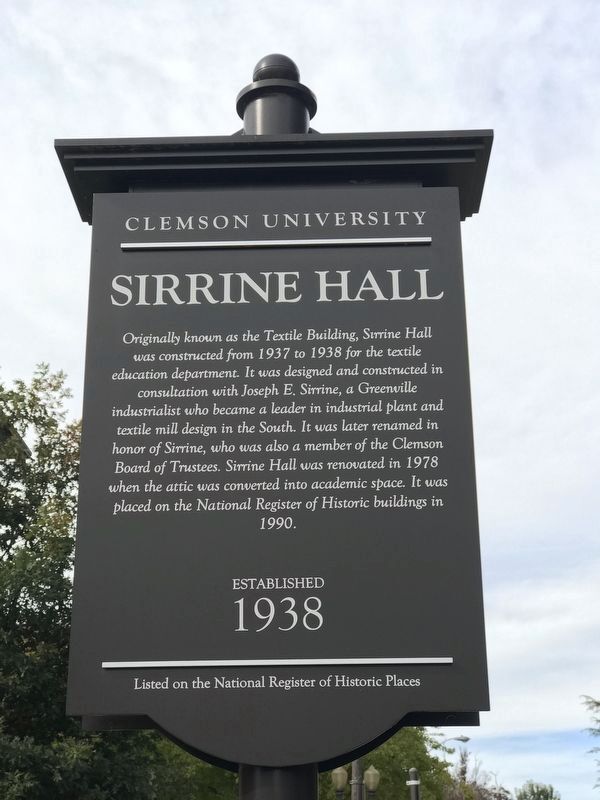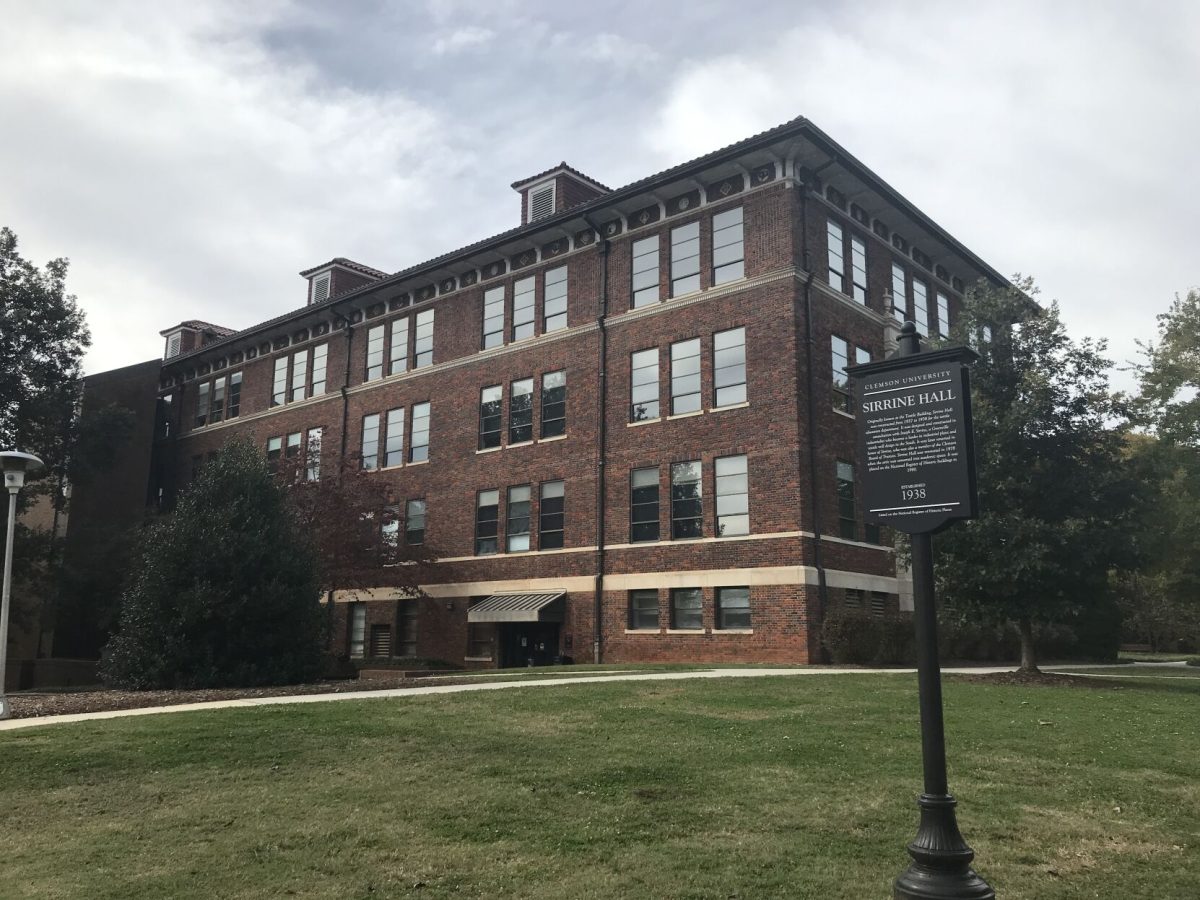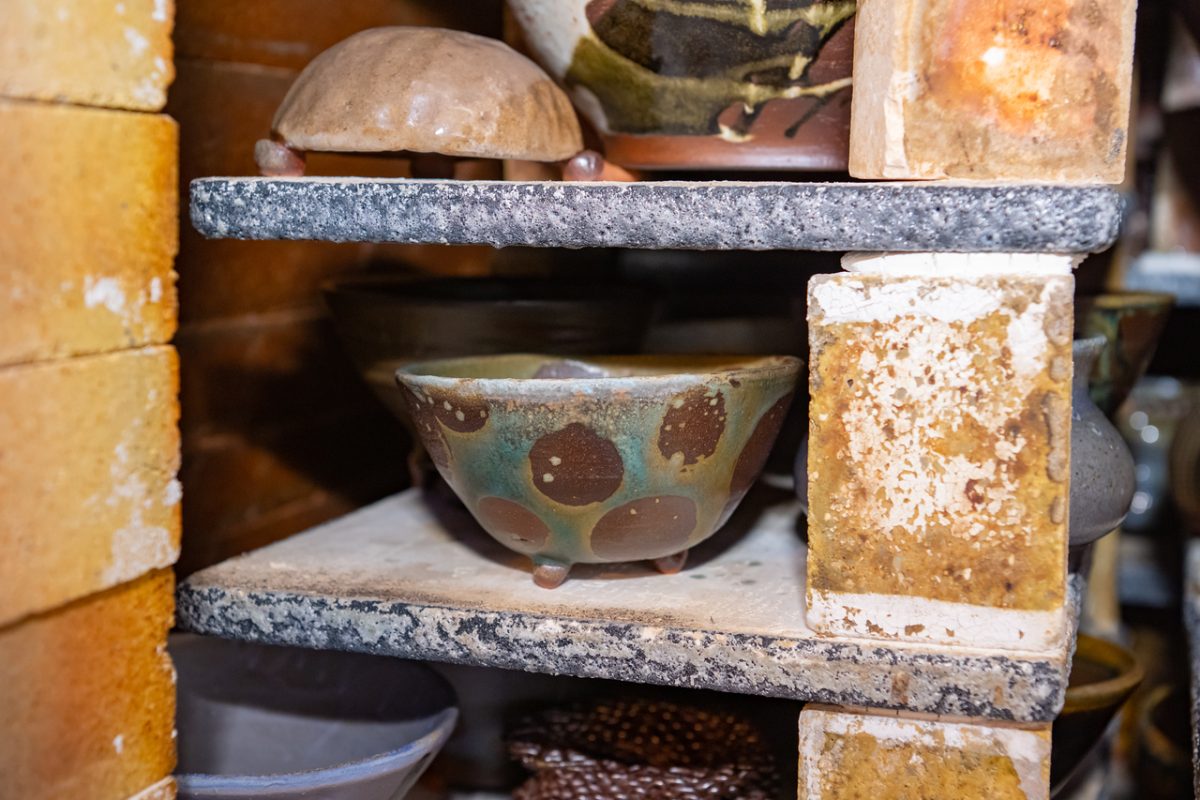What makes Clemson’s campus so unique?
It can be argued that the building architecture is a large reason that Clemson’s campus is a historic preservation in the mountains. The time span of Clemson’s buildings ranges from 1890 to 2022. Some buildings have classic floor designs, while others have a more modern approach with an atrium style. This variety shows the evolution from classic to modern Clemson, according to the Historical Marker Database Online Catalog.
Sirrine Hall, an iconic historical building on Clemson’s campus, was built 84 years ago with its historical significance marked by an antique attribute near one of its many entrances.
“Originally known as the Textile Building, Sirrine Hall was constructed from 1937 to 1938 for the textile education department,” reads Sirrine Hall’s historical marker.
It was designed and constructed in consultation with Joseph E. Sirrine, a Greenville industrialist who became a leader in industrial plant and textile mill design in the South, in consultation with Rudolph E. Lee, the architecture program founder.
It was later renamed in honor of Sirrine, who was also a member of the Clemson Board of Trustees. Sirrine Hall was renovated in 1978 when the attic was converted into academic space. It was placed on the National Register of Historic buildings in 1990,” as noted on Sirrine Hall’s historical marker.
Although Clemson’s architecture varies in style and purpose, most buildings have historical significance and are dedicated to Clemson alumni and supporters.
Alanna Scoggins, a sophomore microbiology major, noted, “When I walk from class to class, it is almost as if I am in a time capsule when I go from the business building to Sirrine. On the one hand, one building has a completely different style, with high ceilings and windows, while the other is the opposite. A lot of campus follows the same theme, and it is something that I wonder about, but I am glad they kept the historical buildings functional because Clemson’s architecture tells quite the story.”
Sirrine Hall reversed the C-shaped footprint used in Riggs, Fike and Long halls, creating an entrance forecourt, as described in the online catalog.
In keeping with the Lee design style, ornamentation includes engraved names of great inventors in the history of textiles, such as Sir Richard Arkwright, creator of a mechanical spinner to make yarn, Eli Whitney, inventor of the cotton gin, the Rev. Edmund Cartwright, inventor of the power loom and Sir William Henry Perkin, who created the first synthetic dye.
“The Sirrine Hall architecture is quite an example of an old building structure — it had traditional brick and siding, with a unique setup that cannot be found in other buildings that have been built since,” said Dan Harding, an associate professor, director of graduate studies in architecture and the director of the community research and design center. “Clemson has developed over the years to adapt to a modern architecture style; that might be why you see such a mix of new and older style buildings.”
In contrast to Sirrine Hall’s classic architecture, the Wilbur O. and Ann Powers College of Business was built in 2020 and has a distinctly modern design to allow for an open space for students to collaborate.
“As one of the architects for the Wilbur O. and Anne Powers College of Business, we focused on creating a more united atrium for students to enter, rather than Sirrine’s more detached classroom and hallway style,” Kathy Hobgood, the assistant director of auxiliary enterprises, said. “They are quite different structures, and the usage of sunlight was something we also focused on in the business building, since Sirrine has a lot of artificial light rather than natural light. We are always looking for ways to incorporate open spaces for students to work together, no matter their major or task, and the newer buildings incorporate more open spaces to facilitate student collaboration.”
For years, Hobgood said, Clemson has transitioned from Sirrine Hall’s style to new styles with more lounges and places for studying outside of classroom work.
Going into the future, it is noted that dorms, such as the high rises, will be demolished and rebuilt with new lounges and places for studying and gathering, which will copy the inspiration from the Honors College Center.
“The architecture will continue to change as time goes on, to reflect where our campus is, but the historical significance of buildings like Riggs and Sirrine Hall, will never be tainted,” Hobgood commented. “Although Clemson is shifting styles, it holds onto history and wants to grow towards a more modern approach.”
Some students reflect on Clemson’s historical architectural styles, while also looking forward to the future changes that will be made.
“I love Sirrine (Hall), but I do also enjoy studying and working in the newer buildings, such as the College of Business,” Jorden Moss, a junior graphic communications major, said. “I think that overall, both have important qualities that I appreciate; older buildings preserve Clemson’s historical significance, while the newer ones have more spaces for studying and are adapting to new technologies seen all over the world, which shows how Clemson is adapting to the world around it.”
Although Clemson’s architecture varies in style and purpose, most buildings have historical significance and are dedicated to Clemson alumni and supporters.










